Lesson 4 - Time Value of Money
This lecture teaches financial analysts the time value of money. The lecture starts with the present value of a single future payment and evolves into the present value of multiple future withdrawals and payments. Finally, an amortization table is constructed for fixed payment mortgage.
Single Investment
1.
The Present Value Formula places a value of future cash flows in terms of money
today.�
- Emphasizes the present
- For example, I deposit $100 into a bank at 5% interest rate.
- After one year, I earn 0.05($100) = $5 in interest.� My balance is $105.00
- After two years, I earn 0.05($105.00) = $5.25.� My balance is $110.25
![]()
If let the money earn interest after n years, then I can build the sequence
![]()
In one-hundred years, $100 grows into $13,150.13 at 5% interest.
![]()
- Notation
- FV is Future Value
- PV is Present Value
- n or t refer to the time
- i is the discount rate or interest rate
- subscripts refer to time
2. Present value - rearrange equation and solve for PV0
- One hundred years is very far away.�
- I rather have the money today.�
- The present value of $13,150.13 in one hundred years is worth $100 to today.�
- I can take that $100 today, invest it in a savings account with 5% interest, and let it grow to $13,150.13
If I receive a payment in the future, then the present value is:

3. Solving for the interest rate
- Example
- You have $10,000 to invest
- You want to earn $15,000
- You want your money in 4 years
- What is the minimum interest rate you need to earn?
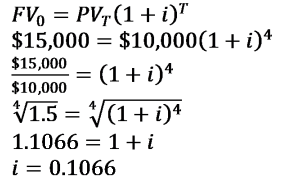
- You need to earn at least 10.66% interest to meet your goals
4. The Rule of 72 - an easy way to determine how long it takes something to double in size
The Equation
![]()
- Examples
- Bank Account
- If your bank deposit is earning 4% per year, divide 72 by 4, and your bank account will double in 18 years
- If your bank deposit is earning 7% per year, divide 72 by 7, and your bank account will double in 10.3 years
- If you plan to put money into a savings account for 5 years, divide 72 by 5, and your interest needs to be 14.4% to double
- Economic Growth
- China's economy is growing 10% per year; divide 72 by 10, which means China's economy will double every 7.2 years
- U.S.A. is growing 1% per year, divide 70 by 1 and the U.S. economy will double in 70 years
- Bank Account
Multiple Investments
- Every year, I invest $500 into the bank account at
6% interest.
- After the first year, I earn $500(0.06) = �$30� My balance is $500 + $30 + $500 = $1,030
- After the second year, I earn $1,030( 0.06 ) = $61.80.� My balance is $1,030 + $61.80 + $500 = $1,591.80
- After the third year, I earn $1,591.80(0.06) = $95.508.� My balance is $1,591.80 + $95.508 + $500 = �$2,187.308
- If I wrote an equation
![]()
- How much is it worth to me today, if I receive $500 today, $500 in one year, $500 in two years, and $500 in three years?
![]()
- If I received $1,836.51 today, I can invest in a savings account and earn $2,187.31 in three years. (Rounding error)
2. Uneven withdrawals and investments
- This formula is flexible.�
- I can withdraw or invest any amounts.
- If the interest rate is 14% and investment time is four years
- For example
| Year | Activity | Amount | Interest + Balance |
|---|---|---|---|
| 0 | Deposit | $100 | $148.15 |
| 1 | Deposit | $300 | $389.88 |
| 2 | Withdrew | $50 | -$57 |
| 2 | Deposit | $100 | $114.00 |
| 3 | Withdrew | $75 | -$75 |
| Total | $520.03 |
- How much are these cash flows worth to me today if interest rate is 14%?
![]()
- If I invest $351.01 today at 14% interest, then in 3 years, I will have $520.04.
Compounding Frequency
- For example, is 1% a good interest rate for a borrower?
- There is no time units.�
- If 1% is annual, then it is a good rate.�
- If it is daily, then the rate is terrible.�
- The borrower borrowed money from a loan shark.
- All interest rates are defined in annual terms, unless otherwise stated.
- Usually loan payments and bank interests are calculated
monthly.�
- Loans could be semi-annually (two payments per year)
- Loans coudl be quarterly (four payments per year).
Adjust the equation as follows

- m is compounding
- Example
- You put $10 in your bank account for 20 years
- Earns 8% interest (APR)
- Compounded monthly
- Your savings grow into:

Note: if this was compounded annually, then it would be $46.61
2. Effective Annual Rate (EFF) - the equivalent interest rate if the compounding were once a year.
- Example: Convert the interest rate 8% APR compounded monthly into an interest that is compounded annnually

- Example: If you put $10 in your bank account for 20 years that earn 8.3% APR compounding yearly, then your savings grow into:

3. Present and future value problems with multiple cash flows can be compounded monthly, semi-annually, or quarterly.
- Example
- What is the present value if I receive $50 within a month, $100 within six months, $75 in exactly one year and one month, and the interest rate is 10%.
- The smallest time unit is the month, so we need to adjust the time units for
interest percent and time.�
- Time is monthly
- Interest rate is 0.1 divided by 12

4. Continuous compounding
Special case
If m approaches infinity, then the compouding equation turns into

- The number e is a constant and equals approximately 2.1828.
- The number e is similar to pi and has not pattern in the number.
- Example
- You deposit $50 into your bank and forget about it for 70 years.
- The bank used continuous compounding, then your savings grow into:
![]()
- If you used monthly compounding, then your savings would be $9,373.90
Annuities and Mortgages
1. Annuity - an investment for people planning for retiring
- Annuities are two types
- Ordinary Annuity - Payment is due at the end of period
- Annuity Due - Payment is due at the beginning of the period
- We will stick to ordinary annuities
- Example - you are investing into an annuity
- Interest rate is 9% APR that is compounded annually
- You are investing in $20,000 per year for five years
- What is the Future Value of your annuity?

- Did you notice the exponents?
- A formula exist that calculates the future value of annuities

- Example
- You plan to retire and you want $40,000 ordinary annuity
- You will pay 4 annual payments at the end of the period
- The interest rate is 3%
- What are your annual payments?
![]()
All future payments are the same, so

2. Calculate a home mortgage. Start with the formula.

- All FVt are future mortgage payments
- r is interest rate (loan rate) and fixed throughout life of the loan.
- PV0 is the bank loan, when you bought the house
All loan payments are the same, so FV = FV1 = FV2 = FV3 = ... = FVt
Incorporate into the equation


- Example
- Mortgage: $60,000
- Interest rate: 12%
- Six-year loan
- Paid yearly

- Solving for FV, your payment yearly payment is $14,594.
- Build an Amortization Table. This table show the breakdown of interest and principal paid for each payment.
- Example
- At the end of Year 1, you have $60,000 outstanding.
- Your interest is 12% multiplied by $60,000, which is $7,200.
- Your payment is $14,594, so interest is $7,200, the remainder reduces the loan balance.
- Year 2, and beyond, repeat the sequence.
| Payment | Interest | Principal Paid | Loan Balance | |
|---|---|---|---|---|
| Year 0 | - | - | - | $60,000 |
| Year 1 | $14,594 | $7,200 | $7,394 | $52,606 |
| Year 2 | $14,594 | $6,313 | $8,281 | $44,325 |
| Year 3 | $14,594 | $5,319 | $9,275 | $35,050 |
| Year 4 | $14,594 | $4,206 | $10,388 | $24,662 |
| Year 5 | $14,594 | $2,959 | $11,635 | $13,027 |
| Year 6 | $14,594 | $1,563 | $13,027 | $0 |
If you pay the mortgage monthly, divide interest rate by 12 and multiply the number of years by 12.
A 20 year mortgage will have 240 payments. I have a program that calculates the amortization table for long time periods.
The amortization table can also handle balloon payments and variable interest rate mortgages.
Comparing Different Investments
1. Net Present Value (NPV) - Calculate the net present value
- Change the present value equation into the form

- You paid out PV0 for the investment
- Any FV's will be negative if it is a payout
- The return to the project is r
- Invest in the project with the highest NPV
- NPV has to equal or greater than zero
- Example
- Your brother wants you to invest $10,000 into his business
- He will promise you $12,000 in two years
- The projected rate of return is 10%
- You buy a T-bill for $9,000
- A year later, the U.S. gov. will pay back $10,000
- The projected rate of return is 4%
- Calculate the NPV's for both situations
- Your brother wants you to invest $10,000 into his business
Brother's business

T-bill investment

- Conclusion - invests in the T-bill
2. Yield to Maturity - set the Net Present Value to zero and solve for the return
- Also called Internal Rate of Return (IRR)
- Use numerical techniques
- I have a program that uses two techniques
- Grid Search - try various r values until NPV equals zero
- Find the Root - an algorithm that finds roots to the equation

- Example:
- Your brother wants you to invest $10,000 into his business
- He will promise you $12,000 in two years
- You can invest in a CD that pays 3% APR
- Your brother wants you to invest $10,000 into his business
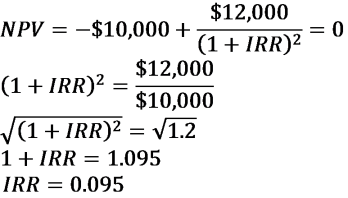
- If you trust your brother, then you earn a higher rate of return.
3. Foreign Currencies - more difficult to deal with
- Exchange rates are continuously changing
- We assume we know the exchange rate at every point in time
- Convert exchange rate to home currency
- Exchange rates are E0, E1, E2, and En

- Example
- You invest 10,000 euros into Greece
- You expect to earn 12,000 euros in two years
- Projected rate of return is 5%
- Exchange rate at time 0 is $1.5 per 1 euro
- Projected exchange rate in two years is $1.6 per 1 euro
- The NPV is

- Instead we had the Greek Financial Crisis
- In Year 2, the exchange rate decreases to $1 per 1 euro
- The NPV is:

- You were harmed by the depreciating Euro
4. Inflation - we can compute a real net present value and a nominal present value.
- Both results in the same number, because the inflation term falls out of the equation.
- Start with real FV and the real interest rate

- Convert the cash flow into nominal by substituting the Fisher Equation into the equation:

- Note - FV's are still in real, but are converted into nominal by multiplying it by expected inflation
Compounding Different Rates of Return
1. What do you do, if over the life of a project, you have different rates of return?
- Example 1
- Year 1, r1 = 10%
- Year 2, r2 = 5%
- Year 3, r3=20%
- Calculating the rate of return is using the geometric average
- r bar is the average rate of return in annualized return
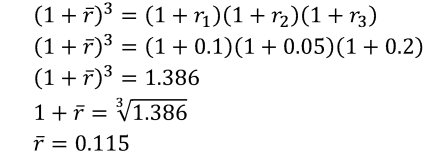
- Example 2
- Year 1, r1 = 50%
- Year 2, r2 = 75%
- Calculating the rate of return is using the geometric average
- r bar is the average rate of return in annualized return
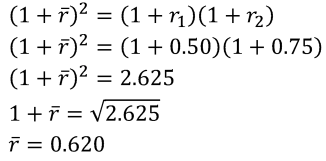
2. What is the present value of the following cash flows from a project with different returns for each year?
- You invest $2,000 today
- Year 1, you receive $1,500 with a 10% interest rate
- Year 2, you receive $1,600 with a 12% interest rate
- Year 3, you receive $500 with a 5% interest rate
- The net present value is:
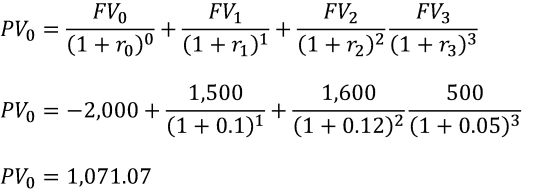
|
|
You should only invest in a project, if the net present value is greater than zero. |